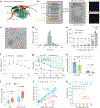Self-powered rapid antigen-specific T-cell response assay for Mycobacterium tuberculosis infections
- PMID: 40579486
- PMCID: PMC12483119
- DOI: 10.1038/s41551-025-01441-5
Self-powered rapid antigen-specific T-cell response assay for Mycobacterium tuberculosis infections
Abstract
Interferon-gamma release assays (IGRAs) that evaluate an individual's T-cell activation response to Mycobacterium tuberculosis (M.tb)-specific peptides serve an important role in diagnosing tuberculosis (TB). However, there are substantial challenges to the use of IGRAs in resource-limited settings. Further, IGRA diagnostic performance can also be compromised in anergic individuals. Here we describe a microfluidic chip-based antigen-specific T-cell response assay (ASTRA) that automates the detection of M.tb-specific T-cell activation responses to facilitate screening for latent M.tb infection and TB. We observe that ASTRA demonstrates high specificity for M.tb infection in independent patient cohorts. Compared with IGRA, ASTRA shows greater diagnostic sensitivity in individuals with HIV-1 co-infections (93.8% versus 67%), comparable diagnostic sensitivity in HIV-negative individuals (92.8%) and faster detection (4 h versus 24-48 h). We also find that a self-powered ASTRA chip that analysed microsample (~25 μl) whole-blood samples produced comparable results. ASTRA holds the potential to facilitate efforts to control the global TB epidemic and serve as a versatile platform for analysing T-cell responses across various infectious diseases and immunotherapeutic interventions.
© 2025. The Author(s).
Conflict of interest statement
Competing interests: The authors declare no competing interests.
Figures







References
-
- Tuberculosis & HIV (WHO, 2023).
-
- Mazurek GH et al. Updated Guidelines for Using Interferon Gamma Release Assays to Detect Mycobacterium tuberculosis Infection—United States, 2010 (CDC, 2010). - PubMed
-
- Almeida Santos J, Duarte R. & Nunes C. Tuberculin skin test and predictive host factors for false-negative results in patients with pulmonary and extrapulmonary tuberculosis. Clin. Respir. J 14, 541–548 (2020). - PubMed
Grants and funding
- R01 AI174964/AI/NIAID NIH HHS/United States
- R01AI177986/U.S. Department of Health & Human Services | NIH | National Institute of Allergy and Infectious Diseases (NIAID)
- R01 AI179714/AI/NIAID NIH HHS/United States
- R01AI179714/U.S. Department of Health & Human Services | NIH | National Institute of Allergy and Infectious Diseases (NIAID)
- R01 AI175618/AI/NIAID NIH HHS/United States
- R21 AI169582/AI/NIAID NIH HHS/United States
- R21AI169582-01A1/U.S. Department of Health & Human Services | NIH | National Institute of Allergy and Infectious Diseases (NIAID)
- U01CA252965/U.S. Department of Health & Human Services | NIH | National Cancer Institute (NCI)
- R01 HD103511/HD/NICHD NIH HHS/United States
- R01HD103511/U.S. Department of Health & Human Services | NIH | Eunice Kennedy Shriver National Institute of Child Health and Human Development (NICHD)
- R01 AI177986/AI/NIAID NIH HHS/United States
- R01AI173021/U.S. Department of Health & Human Services | NIH | National Institute of Allergy and Infectious Diseases (NIAID)
- R21AI169582/U.S. Department of Health & Human Services | NIH | National Institute of Allergy and Infectious Diseases (NIAID)
- R01HD090927/U.S. Department of Health & Human Services | NIH | Eunice Kennedy Shriver National Institute of Child Health and Human Development (NICHD)
- R01 AI137527/AI/NIAID NIH HHS/United States
- U01 CA252965/CA/NCI NIH HHS/United States
- R21 NS130542/NS/NINDS NIH HHS/United States
- R01 AI144168/AI/NIAID NIH HHS/United States
- R01AI144168/U.S. Department of Health & Human Services | NIH | National Institute of Allergy and Infectious Diseases (NIAID)
- R01 HD090927/HD/NICHD NIH HHS/United States
- R01 AI173021/AI/NIAID NIH HHS/United States
- R01AI175618/U.S. Department of Health & Human Services | NIH | National Institute of Allergy and Infectious Diseases (NIAID)
- R01AI174964/U.S. Department of Health & Human Services | NIH | National Institute of Allergy and Infectious Diseases (NIAID)
LinkOut - more resources
Full Text Sources

